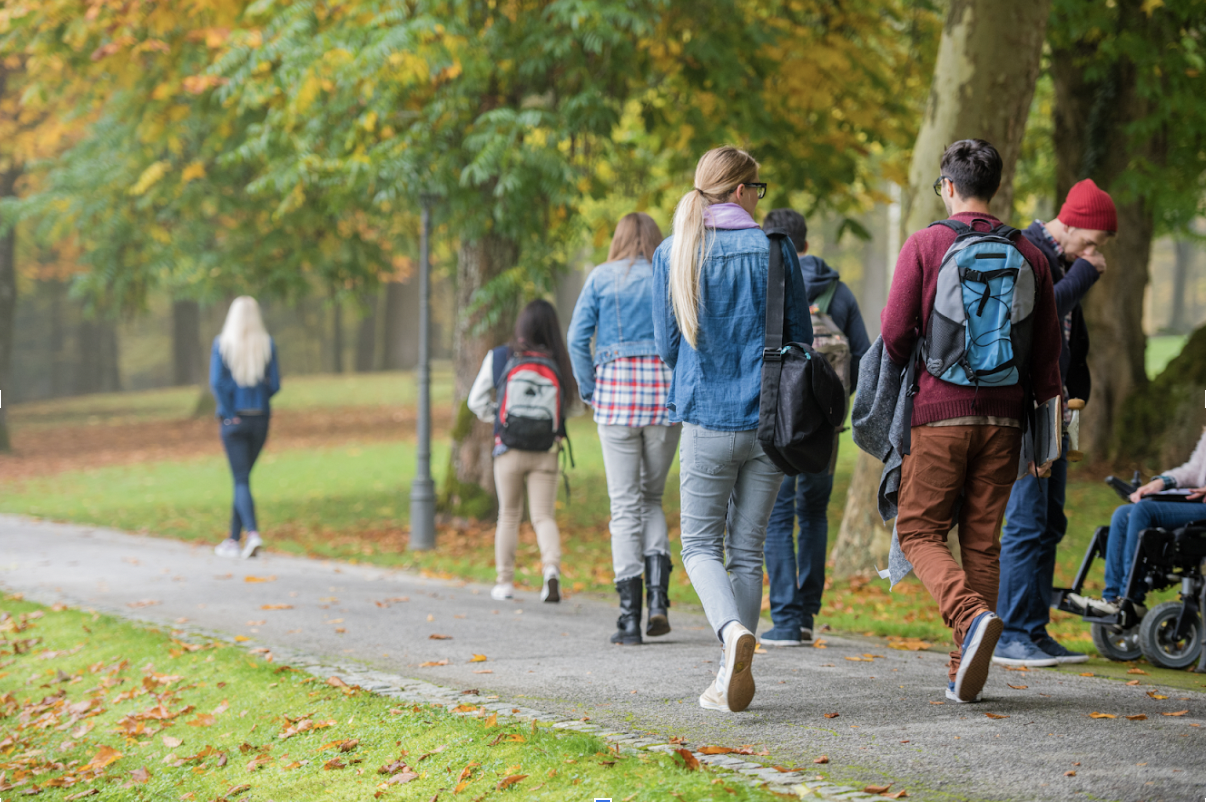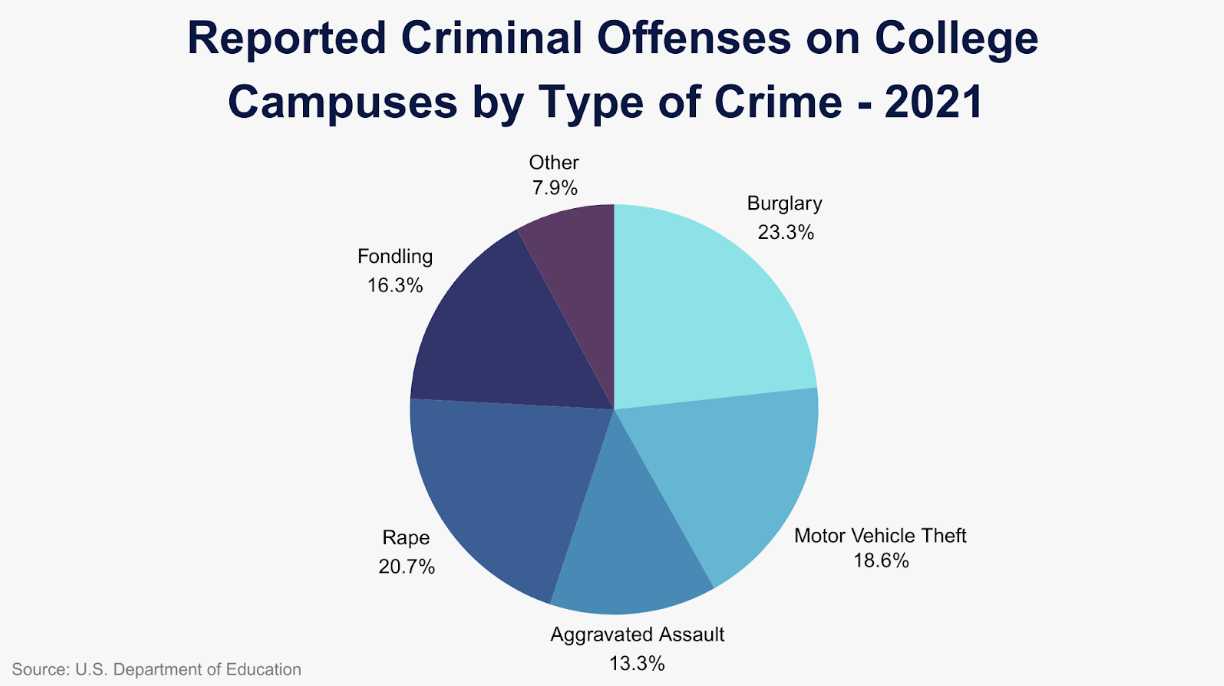6 Safety Tips for College and University Students
Returning to school is a fun, exciting time full of opportunity. But regardless of your background, stepping onto a college campus for the first time can be scary. For most, it is the first time away from home. It’s the first time away from family. And usually, it is also the first time away from your closest friends.
As a recent college graduate, I still remember how I felt when my parents drove away for the first time after dropping me off. I felt so much freedom and excitement, but I also felt scared and nervous about navigating a new environment. After all, there are scary things out there, and I never had to deal with any of them on my own until now.
In this post, we will explore the impact of campus crime, share practical steps students can take to minimize the risk of being victimized, and offer valuable resources to help ensure your safety on campus.
I recall one night my roommate went to a college bar with a friend, just the two of them. They took drinks from a group of men they didn’t know, graciously accepting the free drinks and not knowing any better. She told me later that the drinks were on the table at a booth, came directly from a bottle provided by the bar, and looked seemingly untouched.
Neither of them remembered anything after that. My roommate woke up in a fog the next morning, not knowing how she got home or what happened to her. Eventually, we learned that a group of our close friends noticed their strange text messages, came to the bar, and took them home safely to bed. My roommate had been roofied, and the outcome could have been much worse if our friends had not shown up.
After that night, I vowed to be much more situationally aware. Inevitably, there were a few times after that when I was caught in dangerous situations, but I knew I had to be smart about how I handled them. I also realized that being safe doesn’t only apply to partying.
For example, I often drove to my downtown San Francisco campus for night classes ending at 9:30 p.m. I usually had to park a few blocks away, but I always asked classmates to walk me to my car after class. In return, I would drive them to theirs. There is strength in numbers.
Of course, there are situations you can never be fully prepared for. However, there are things you can do to mitigate potential risks. Whether you are an athlete like me traveling for games every week, in Greek life going to parties and socials, or just walking to and from class, it is important to do everything you can to keep yourself safe. A student going to college should come with the knowledge to recognize potential threats and avoid bad situations.
Understanding Campus Crime: Key Statistics and Trends
According to the latest data from the U.S. Department of Education's Campus Safety Survey, there were 31,137 criminal offenses reported on over 10,000 college campuses in 2021. The most common crimes reported were burglaries (23%), rape (21%), motor vehicle thefts (19%), and unwanted touching or fondling (16%).
Of those 31,137 crimes, 42% were classified as Violence Against Women Act (VAWA) offenses, which include domestic violence, dating violence, and stalking.
Hate crimes are offenses like vandalism, arson, assault, or murder that are motivated by bias against the victim's race, religion, disability, sexual orientation, ethnicity, gender, or gender identity. In 2021, there were 1,626 hate crimes reported on college campuses — the highest number ever reported since the Department of Education began collecting data in 2005. Over the last 16 years, the number of reported hate crimes has increased by nearly 3,600%.
These alarming statistics emphasize the urgent need for all students to take proactive measures to minimize risks and ensure campus safety. It is important to take responsibility for our own safety.
How Crime Patterns Affect Your Personal Safety
Recognizing crime patterns and their importance in daily life can help you be more aware of your surroundings. The Crime Triangle and the Routine Activities Theory explain how opportunities for crime happen and how they are influenced by our environment and situations.
For a crime to occur, there are three elements that must happen at the same time:
-
This is an individual with the intent or desire to commit a crime, such as a burglar, robber, vandal, or anyone with criminal intentions. Motivated offenders generally look for opportunities that offer the highest potential reward with the least risk. As a result, they tend to be selective in choosing the location, time, and target of their crime.
-
In this context, “suitable” refers to the characteristics of a potential target that make it more attractive to an offender. A suitable target is a person or property that is accessible to the offender and appears vulnerable or easy to victimize. Factors like being alone, being in the dark, and having no witnesses or help around can make someone or something a suitable target. For example, a car left unattended might be a suitable target for theft, and someone walking alone at night might be a suitable target for robbery.
-
Capable guardianship means having people or security measures that protect a potential target or stop a crime if it happens. For example, in a public place, police officers are a type of capable guardian. At home, a security system or watchful neighbors can act as capable guardians. Personal self-defense tools like pepper spray also increase guardianship. You are more likely to become a victim when you are in a situation without capable guardianship.
You can learn more about the crime triangle in our companion post, “Awareness: A Key to Women’s Self Defense.” In that post, we provide helpful information about these topics that apply to any student returning to school, not just women.
Essential Safety Tips for College Students
If you can remove just one of these three elements, then the chances of a crime occurring decrease significantly. With a few mindful practices, students can enhance their personal safety and protect their belongings.
Here are six practices to help you stay safe in a campus setting:
-
Whether walking home after class or out late studying with friends, experts advise students to practice the “buddy-system” and find another student or group to walk with at night. If that is not an option, many campuses have school-offered escort services and shuttles like “SafeRides” or “SafeWalks.” Another preventative safety measure students can take is sharing their location with a trusted friend, roommate, or family member. It is also important to be aware of your surroundings, which means not wearing headphones or being distracted by a cell phone while walking. Walking in well-lit areas and avoiding empty parking lots is also smart.
-
Students should always lock the doors to their car, locker, dorm room, apartment, or house at all times - especially before going to bed. It is a good idea to keep your door locked even when you are inside the room or vehicle. Also, it is wise to double-check that all windows are closed and locked before you leave. To prevent theft, do not leave valuable items inside a vehicle or out in the open. You can also get inexpensive door alarms from Amazon or another retailer, that you can easily install yourself.
-
While it is true that most college dorms are secured and require key card access, this could be mistaken as a false sense of security. Some students may feel that locking the door would be pointless, but it is always a good idea. Students will often hold the door open for the person behind them just to be polite. Experts advise against this, however, even if telling someone they can’t come in seems rude. Many campuses are typically open to the public. If you see someone on campus who appears suspicious, look for behavioral cues like wandering, nervousness, unusual behavior, or hostility. Also, watch for suspicious vehicles moving slowly without lights or parked at odd times. If you notice something, try to get a description of the person and their actions, and note any vehicle license plates that are involved. Get to a safe place and report their activity to campus safety or the police.
-
Like it or not, parties are a staple activity on most college campuses. Students who choose to attend should do so safely and legally. Before going out to an event, always have a plan for how you will get home. There is strength in numbers, so always try to go to the party with a group of people, and never by yourself. Never leave your drink unattended, and never accept drinks from strangers. There are also drink covers you can buy to help prevent drink tampering. Additionally, it is advised to leave with the people you came with. Always trust your gut - if something feels wrong, it probably is wrong.
-
Safety and support services are different from school to school, but most campuses have various resources. Many schools have a blue light system spread across campus, where you can push a blue button to alert officers of an emergency instantly. Schools typically also have campus security or campus police patrols you can call at any hour of the day. They also often have emergency notification systems to inform students and faculty of potentially dangerous incidents nearby. Most schools will give out safety information at freshman orientation, so it is important to attend that day. At orientation, they will often provide resources for bystander intervention, consent, sexual assault, dating violence, and active shooter situations. All campuses are required to have Title IX coordinators and counseling services. Be sure to check which services your campus provides. It is also a smart idea to put those important safety numbers as contacts in your phone, just in case.
-
We often say, "If you see something, say something." Experts encourage students to report any suspicious behavior or unsafe activities, like someone leaving bags unattended or a car driving slowly around campus. Campus safety apps often let you report things anonymously. If you feel like someone is following you, go straight to the police, campus security, or a safe place.
Enhancing Your Situational Awareness on Campus
One of the most important things you can do to keep yourself and others safe at school is to increase your situational awareness. Situational awareness involves being aware of one’s surroundings, recognizing warning signs of potential threats, and proactively taking measures to mitigate risks.
Whether you're a first-time college student or returning for another year, enhancing your personal safety is crucial. By practicing situational awareness, you can protect yourself and stay safe. For parents, encouraging your college-bound children to be more situationally aware can significantly contribute to their safety on campus.
To learn more about situational awareness training, check out our companion post, "The 4 Benefits of Situational Awareness." At Second Sight Training Systems, we know how important situational awareness is for maintaining a safe campus environment.
Our Situational Awareness for Safety training will help students learn to recognize and respond to potential threats. After just a short time, students will be systematically observing their surroundings, looking for behavior patterns, identifying threats, and knowing what actions to take to keep themselves safe.
After taking this course, participants agreed that they felt better prepared to:
Observe any environment - 98.8%
Look for and identify threats - 98.7%
Take action and keep themselves safe - 93.1%
With a track record of successfully training thousands of participants, we are committed to enhancing student safety. Our 1-hour online training is available now and can accommodate any number of participants. Additionally, we offer a comprehensive 2-hour virtual and in-person instructor-led training for a more interactive experience.
While the transition to college life is a thrilling adventure, it also comes with new responsibilities, including staying vigilant about personal safety. By understanding the patterns of campus crime and implementing the practical safety tips outlined in this guide, you can significantly reduce your risk and enhance your overall campus experience.
-
About the Office on Violence Against Women. U.S. Department of Justice Office on Violence Against Women. (2016). https://www.justice.gov/ovw/file/858106/dl?inline=
Blue Emergency Phones: What They’re for and How They Help. Axon. (2024). https://www.axon.com/resources/blue-emergency-phones
Bryant, J. (2023, August 15). College Campus Crime and Safety Statistics: BestColleges. BestColleges.com. https://www.bestcolleges.com/research/campus-crime-statistics/
Cohen, L. E., & Felson, M. (1979). Social Change and Crime Rate Trends: A Routine Activity Approach. American Sociological Review, 44, 588-608. https://faculty.washington.edu/matsueda/courses/587/readings/Cohen%20and%20Felson%201979%20Routine%20Activities.pdf
FBI. (2016, May 3). Hate Crimes. FBI. https://www.fbi.gov/investigate/civil-rights/hate-crimes
Nightcap Scrunchie. NightCapIt. (2024). https://nightcapit.com/products/nightcap-scrunchie
SafeRide Programs. NASRP. (2024). https://www.nasrp.org/saferide-programs
SafeWalk Program. SafeWalk | University Police Department. (2024). https://upd.sfsu.edu/safewalk
The Problem Analysis Triangle. ASU Center for Problem-Oriented Policing. (2021, July 3). https://popcenter.asu.edu/content/problem-analysis-triangle-0
U.S. Department of Education Campus Safety & Security Survey. (2021). https://surveys.ope.ed.gov/campussafety
U.S. Department of Education. (2021, August 20). Title IX and Sex Discrimination. U.S. Department of Education. https://www2.ed.gov/about/offices/list/ocr/docs/tix_dis.html
Wood, S. (2023, March 28). How to Stay Safe on a College Campus. U.S. News. https://www.usnews.com/education/best-colleges/articles/how-to-stay-safe-on-a-college-campus






